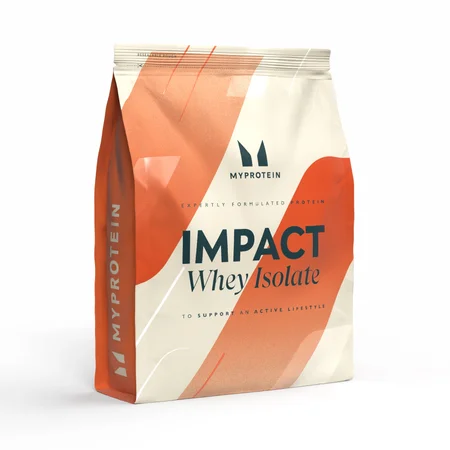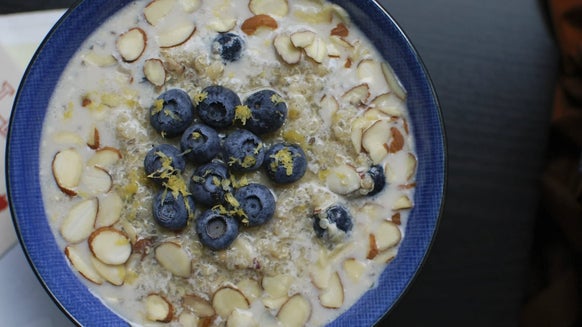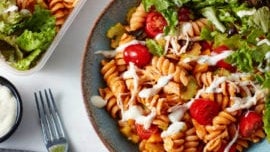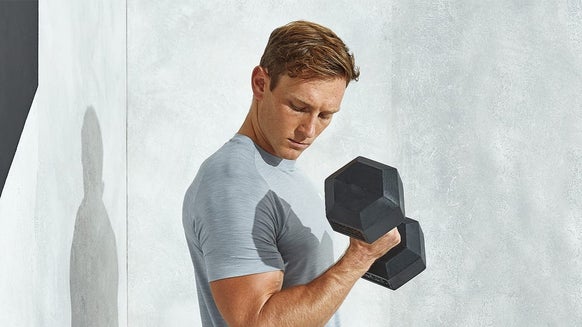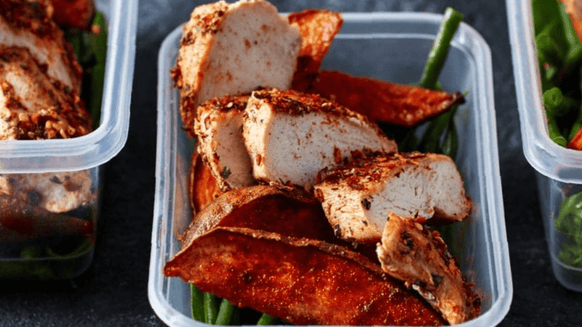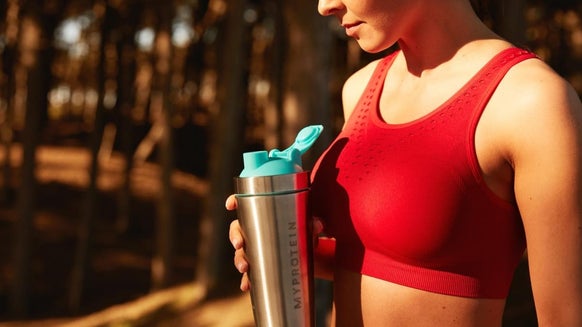The Key Ways To Reduce Body Fat Fast

Burning body fat or losing weight are two of the most common reasons that anyone hits the gym. Although it’s not always easy, losing weight and reducing body fat doesn’t have to be complicated.
When trying to lose weight, we want to target body fat for reduction while maintaining our muscle mass. Generally, weight loss comes down to simple maths — burning more calories (through exercise) than we’re eating.
Ways to lose body fat
Research shows that belly fat (or visceral fat) is actually the most dangerous to our health — more belly fat has been shown to be associated with increased risk of heart disease.1 There are a few key tips that can help you target fat loss fast and be successful keeping the fat off. The five keys to burning fat are: protein, fibre, weight lifting, cardio, and limiting sugar.
In this article, you'll find:
Fat loss nutrition
Exercise for fat loss
Anaerobic exercise for fat loss
Aerobic exercise for fat loss
LISS for fat loss
HIIT for fat loss
Best ways to reduce belly fat
Biggest mistakes when trying to lose body fat

Nutrition
When it comes to losing body fat, nutrition is the most important component. It’s much easier to sabotage your fat loss by overeating and it becomes much harder to compensate by working harder at the gym.
Although there are many schools of thought about the best diet for weight loss, they all have one thing in common — calorie reduction.2 Whether you need to cut out empty carbohydrates and follow a high-fat ketogenic diet, or reduce your intake of fatty foods and follow a simple low-calorie diet, or try intermittent fasting — the key is to find a plan you can follow and stick to it for the long term.
However, fad diets and macro considerations aside, it’s important to choose healthy foods when it comes to the calories you’re fuelling your body with.
For a personalised diet plan, always consult your physician or a registered dietician, but following basic guidelines can help you follow a healthy diet that will lead to fat loss.
You should also consider all three macronutrients — carbohydrates, proteins, and fat. There are ways to make good and bad choices with all of these food groups. When it comes to carbs, choose whole grains, fruits, and vegetables instead of large portions of refined grains and added sugars.
Protein
With protein, choose lean options over fatty meats, opt for fish a few meals per week, and focus on plant-based proteins when possible. When you’re cooking, use heart-healthy oils and limit saturated animal fats like butter or lard. Choose dietary fats from fatty fish, avocados, nuts, and seeds instead of deep-fried foods and animal-based fat sources. Try cutting out added sugar found in sweetened beverages and desserts.

Throughout a weight loss journey when we want to try burn fat specifically, it’s important to take in adequate amounts of protein to protect our muscle mass. Research shows that higher levels of protein during weight loss make it more likely to keep the weight off and help to target fat loss.3
Based on your level of exercise, you might need to supplement with extra protein (like Impact Whey Protein) to consume enough to help keep your muscle mass while you burn fat.
Fibre
Another helpful consideration when losing weight is fibre — getting adequate soluble fibre from fruits, vegetables, and whole grains will help you feel more satisfied and improve your digestion. If you don’t think you get enough soluble fibre in your diet, you can consider a supplement. Research has shown links between soluble fibre and successful fat loss.4
It sounds like a lot to think about, but really following a healthy balanced diet doesn’t need to be complicated. When you’re trying to lose weight, you want to make sure that you feel satisfied — being hungry all the time isn’t essential for burning fat. Choosing satisfying, whole foods and using supplements when you need them can be easy and sustainable to help you meet your fat loss goals.
Exercise
Looking back to the basic fat loss equation, you need to be burning calories — that’s where exercise comes in. We all burn a different amount of calories even when we aren’t exercising (known as our resting metabolic rate) based on our body size and composition.
While it’s difficult to measure this number exactly — even in a laboratory setting — there are some equations that can help you estimate about how many calories you burn at rest (if you’re interested, check out the Harris-Benedict equation).
Anaerobic Exercise
Individuals with more lean mass (muscle) burn more calories at rest than those with more fat mass. Think of muscle as active, calorie burning tissue, while fat is hanging out there for storage purposes without burning as much energy.
This is one of the reasons many people exercise — to optimise the ratio of muscle mass to fat mass, which burns more calories in the long term. We can boost this lean muscle mass through weightlifting, or anaerobic exercise.
One strategy of weightlifting is called “drop sets”. This means lifting your heaviest weights for a designated amount of sets and reps, and then doing the same exercise with lighter weights until your muscles fatigue. It trains your muscles to work harder and see optimal results. Another strategy is to use “super sets”, where you work two opposing muscle groups immediately one after the other without taking a break to recover. Talk to a personal trainer if you’re interested in incorporating either of these strategies into your workouts.
Aerobic Exercise - Cardio
The other key part of exercise for losing fat is aerobic activity. “Aerobic” doesn’t have to mean the stereotypical ‘90’s step aerobics class with leg warmers and sweat bands, but it can be any form of heart-pumping activity, from speed-walking to high intensity interval training (HIIT). In fact, both types of cardio, or aerobic exercise, have key benefits and should be incorporated in to your weekly routine.
LISS – Low intensity steady state
LISS cardio is your basic ‘jog-in-the-park-style’ cardio workout, when you’re working at a low or moderate pace for a longer period of time. This might be running, cycling, swimming, or using an elliptical machine at the gym. Low intensity steady state cardio is appropriate for almost all fitness levels and targets your heart rate in the “fat burning zone” for a longer period of time.
HIIT – High intensity interval training
HIIT is a newer approach to cardio that involves shorter, more intense bursts of exercise;think multiple sprints at short distances versus a slower jog for a longer distance. This type of exercise challenges your body and often makes your hear trate elevate quickly, but for a much shorter period of time than LISS. HIIT training can help you teach your body to recover faster and even lead to increased performance during your LISS workouts.

Best ways to reduce belly fat
Sugar
Belly (visceral) fat is the most dangerous fat to our health. Researchers have found that the biggest dietary culprit when it comes to belly fat is added sugar.1 Specifically, sugar-sweetened drinks (juices, fancy coffee drinks, soda, etc.) play a large role in the accumulation of belly fat.5
Over time, this not only leads to a larger waistline but also the increased possibility of type-2 diabetes and heart disease. When you’re choosing your post-workout shakes and protein bars, make sure you aren’t overloading on the sugar.
Basics
Overall, the best ways to lose body fat are to stick to the basics — a healthy diet and a consistent exercise routine. If you haven’t been seeing results, try switching up your exercise routine and incorporating some new strategies to challenge your muscles.
Biggest mistakes when trying to lose body fat
There are a few pitfalls to avoid when trying to lose body fat. First, don’t restrict your food and calorie intake too much — too few calories when working out hard can actually start to break down muscle as well as fat. Secondly, don’t sabotage your workouts by overeating the wrong foods — specifically sugar. Finally, remember that losing fat and keeping it off can take some time — fad diets that promise quick fat loss typically aren’t sustainable long term and may be detrimental to your health.
Take home message
There are lots of strategies out there when it comes to fat loss, but it’s best to stick with the basics. A healthy diet with adequate protein, soluble fibre, and limited sugars can help target fat loss, along with a workout routine of weightlifting (to increase and maintain muscle mass) and varied cardio (ideally a combination of LISS and HIIT). Following these tips will not only help you lose fat, but also keep your body healthy.

Claire is a Registered Dietitian through the Academy of Nutrition and Dietetics and a board-certified Health and Wellness Coach through the International Consortium for Health and Wellness Coaching. She has a Bachelor of Science in Biology and a Master’s degree in Clinical Dietetics and Nutrition from the University of Pittsburgh.
Talking and writing about food and fitness is at the heart of Claire’s ethos as she loves to use her experience to help others meet their health and wellness goals.
Claire is also a certified indoor cycling instructor and loves the mental and physical boost she gets from regular runs and yoga classes. When she’s not keeping fit herself, she’s cheering on her hometown’s sports teams in Pittsburgh, or cooking for her family in the kitchen.
Find out more about Claire’s experience here.


